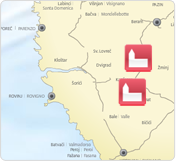
- Gradišće – Koper
- Podpeč – Zanigrad – Hrastovlje
- Slum – Roč – Hum
- Draguć – Paz – Gradinje – Gologorica
- Pićan – Gračišće – Lindar
- Pazin – Beram
- Oprtalj – Čirkoti – Rakotule
- Vižinada – Božje polje – Labinci
- Višnjan – Bačva – Poreč
- Sv. Lovreč – Kloštar
- Šorići – Dvigrad – Kanfanar
- Žminj – Svetvinčenat
- Bale – Batvači – Fažana – Pomer
- Bičići – Barban – Prodol
- Jasenovik – Nova Vas – Vranja
- Plomin – Brseč – Lovran
Žminj – Svetvinčenat
Svetvinčenat
St. Vincent
Although it is in the vicinity of Pula, in the Middle Ages Svetvinčenat was under the authority of the Poreč diocese. It was once the site of the Benedictine monastery. In 1178 the well-known Pope Alexander III confirmed St. Vincent's Church to the Poreč bishop cum cappelis suis. Svetvinčenat, that is the district-prefect of St. Vincent's abbey, is mentioned in the most significant Istrian document, Survey of Istrian Land Boundaries (Istarski razvod), which bears witness of the development of a medieval settlement around the monastery. From 1209, when it became the possession of the Margrave of Istria, it changed many different owners, until it completely became the possession of the Venetian Morosini family in 1523. At that time it acquired its present day appearance with one of the most beautiful and harmonious Renaissance squares.
Today, St. Vincent's Church is the only remains of the monastery that existed until 1314. It is especially interesting from the architectural point of view, as a single-naved church with three inscribed apses. Of the three layers of frescoes, the oldest, first layer is only suggested by traces of faded color. The second, most significant one dating from the end of the 13th c. is attributed to Master Ognobenus from Treviso as evidenced by the inscription under the window of the southern apse. The third layer, dating from the second half of the 14th c. depicts the restored images of Apostles and partly preserved altar painting on the northern wall depicting an image of a female saint and the donator. On the side walls Ognobenus illustrates the Martyrdom of St. Vincent and St. Valerius, as well as scenes from the Life of Christ. In the apses are scenes of the Baptism of Christ, Maiestas Domini and Maiestas Virginis. The wide triumphal arch reveals both scenes of the Annunciation and Cain and Abel's Offering. Iconographically interesting is the oldest calendar with allegorical representations of months. The frescoes are significantly damaged due to the humidity of walls. Perhaps it is this very patina and mystical quality that render these frescoes so fascinating.
Imprimer la page Envoyer a un ami



















